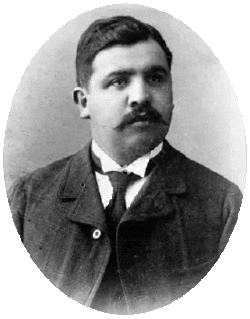Rafael Monroy is remembered by Mormons in Mexico as a martyr of The Church of Jesus Christ of Latter-day Saints (Mormon or LDS Church)
Monroy joined the LDS Church in 1913. Shortly after this, Rey L. Pratt and the other missionaries of American citizenship were forced to leave because of the Mexican Revolution. Monroy was made a branch president by Pratt.
President Raphael Monroy and his counselor; cousin/brother-in-law Vincente Morales were taken prisoners by Liberation Army of the South or Zapatistas. When asked their show his weapons, Raphael held up the Bible and Book of Mormon and said "These are the only weapons I carry". They were told their lives would be spared if they would denounce their faith. When they refused, they were executed in San Marcos, Hidalgo, Mexico.
One author wrote of the family's loss:
"It had rained most of the night, and the air was damp. Jesucita Monroy (Rafael's mother)had not slept and was out on the street early, pleading with the officers of the Zapatista army... Her early morning appeal was successful, and the Zapatistas released her three daughters from army custody. After getting two of her daughters home, Jesucita and her oldest, Guadalupe, went to the place where the two executions had taken place the evening before. Already burdened with emotion and grief, these two women began the task of moving the … bodies of their son and brother, Rafael, and their nephew-in-law and cousin-in-law, Vicente Morales, home to prepare for the funeral and burial. Victims of the brutality of a civil war in Mexico, these two men had lost their lives in the violence they had deplored. For many members of the family and for many friends, Rafael and Vicente became examples of faith and dedication to The Church of Jesus Christ of Latter-day Saints." (Mark L. Grover, "Execution in Mexico: The Deaths of Rafael Monroy and Vicente Morales," BYU Studies 35, no. 3 [1995–96]:7).
Amid her struggle, Sister Monroy—a widow, proprietor of a small and maligned grocery store, friend to North American missionaries, and now the principal strength for her three daughters—carried on. She pled with Zapatistas and Constitutionalists alike to spare Church members. Even amid her immense sorrow, she maintained contact with as many Latter-day Saints as she could. She also wrote long letters to President Pratt. Despite her anguish, she became a balm to others in the village who were also suffering.
Rafael Monroy and Vicente Morales offered the supreme sacrifice. Their roles as martyrs helped to anchor the lives of many Mexican Latter-day Saints in the gospel, while Sister Monroy's firmness in sorrow and constancy in the face of affliction inspired many generations of Latter-day Saints to lives of fidelity and courage. Because of pioneers like them, the Church in San Marcos has grown strong.
Buried- 19 July 1915 at Tula, Hildago, Mexico.
Rafael Monroy is remembered by Mormons in Mexico as a martyr of The Church of Jesus Christ of Latter-day Saints (Mormon or LDS Church)
Monroy joined the LDS Church in 1913. Shortly after this, Rey L. Pratt and the other missionaries of American citizenship were forced to leave because of the Mexican Revolution. Monroy was made a branch president by Pratt.
President Raphael Monroy and his counselor; cousin/brother-in-law Vincente Morales were taken prisoners by Liberation Army of the South or Zapatistas. When asked their show his weapons, Raphael held up the Bible and Book of Mormon and said "These are the only weapons I carry". They were told their lives would be spared if they would denounce their faith. When they refused, they were executed in San Marcos, Hidalgo, Mexico.
One author wrote of the family's loss:
"It had rained most of the night, and the air was damp. Jesucita Monroy (Rafael's mother)had not slept and was out on the street early, pleading with the officers of the Zapatista army... Her early morning appeal was successful, and the Zapatistas released her three daughters from army custody. After getting two of her daughters home, Jesucita and her oldest, Guadalupe, went to the place where the two executions had taken place the evening before. Already burdened with emotion and grief, these two women began the task of moving the … bodies of their son and brother, Rafael, and their nephew-in-law and cousin-in-law, Vicente Morales, home to prepare for the funeral and burial. Victims of the brutality of a civil war in Mexico, these two men had lost their lives in the violence they had deplored. For many members of the family and for many friends, Rafael and Vicente became examples of faith and dedication to The Church of Jesus Christ of Latter-day Saints." (Mark L. Grover, "Execution in Mexico: The Deaths of Rafael Monroy and Vicente Morales," BYU Studies 35, no. 3 [1995–96]:7).
Amid her struggle, Sister Monroy—a widow, proprietor of a small and maligned grocery store, friend to North American missionaries, and now the principal strength for her three daughters—carried on. She pled with Zapatistas and Constitutionalists alike to spare Church members. Even amid her immense sorrow, she maintained contact with as many Latter-day Saints as she could. She also wrote long letters to President Pratt. Despite her anguish, she became a balm to others in the village who were also suffering.
Rafael Monroy and Vicente Morales offered the supreme sacrifice. Their roles as martyrs helped to anchor the lives of many Mexican Latter-day Saints in the gospel, while Sister Monroy's firmness in sorrow and constancy in the face of affliction inspired many generations of Latter-day Saints to lives of fidelity and courage. Because of pioneers like them, the Church in San Marcos has grown strong.
Buried- 19 July 1915 at Tula, Hildago, Mexico.
Sponsored by Ancestry
Advertisement
Explore more
Sponsored by Ancestry
Advertisement


